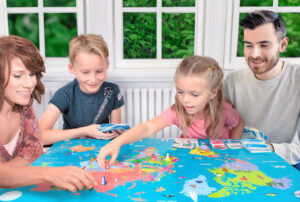It’s important to know what to look for in a baby rattle, as for many of us, a baby rattle was our first toy. Rattles are bright and engaging, and can even yield tremendous benefits for your baby, both cognitively and visually. But with the wide variety of baby rattles on the market, how can you know if you’ve chosen the right one? The wrong one may fail to hold your infant’s interest—or worse, it may be dangerous. If you keep your eye out for these key features, you’ll be sure to find the perfect rattle for your baby.
Soft & Safe
Any toy you give your little one will inevitably find its way into their mouths, or they may accidentally hit themselves or others in the face with it from time to time. As a result, the ideal baby rattle will be plush, non-toxic, and large enough that they can’t swallow it (at least 2” in diameter). Make sure toys don’t have loose pieces or jagged edges that may pose additional risks. Older babies can be aggressive chewers, so always replace any toys that have chew marks, as these rough spots can scrape or cut your baby’s skin or mouth.
Engaging & Playful
Babies can be entertained by nearly anything, but if you’d like your chosen rattle to become a longtime favourite, you should choose one that will keep their attention. Many rattles come in friendly animal shapes, bright colours, and interesting textures to keep your infant active and interested. Not only will they remain engaged longer, but visually stimulating toys help babies learn to track objects with their eyes, vastly improving their vision. Soft, padded rattles will have the additional bonus of soothing the sore gums of teething babies.
Our rattles are durable and for unlimited playtime at any age.
As your baby grows older, they will have different needs when it comes to their toys. Infants around 2-3 months old are delighted by noisemakers, and these noisy toys can help them learn to use their hands. Older babies, on the other hand, may prefer toys they can chew.
If you choose the right rattle, it can last your little one through each of these phases, changing from a simple noisemaker to a childhood companion as your baby grows.



